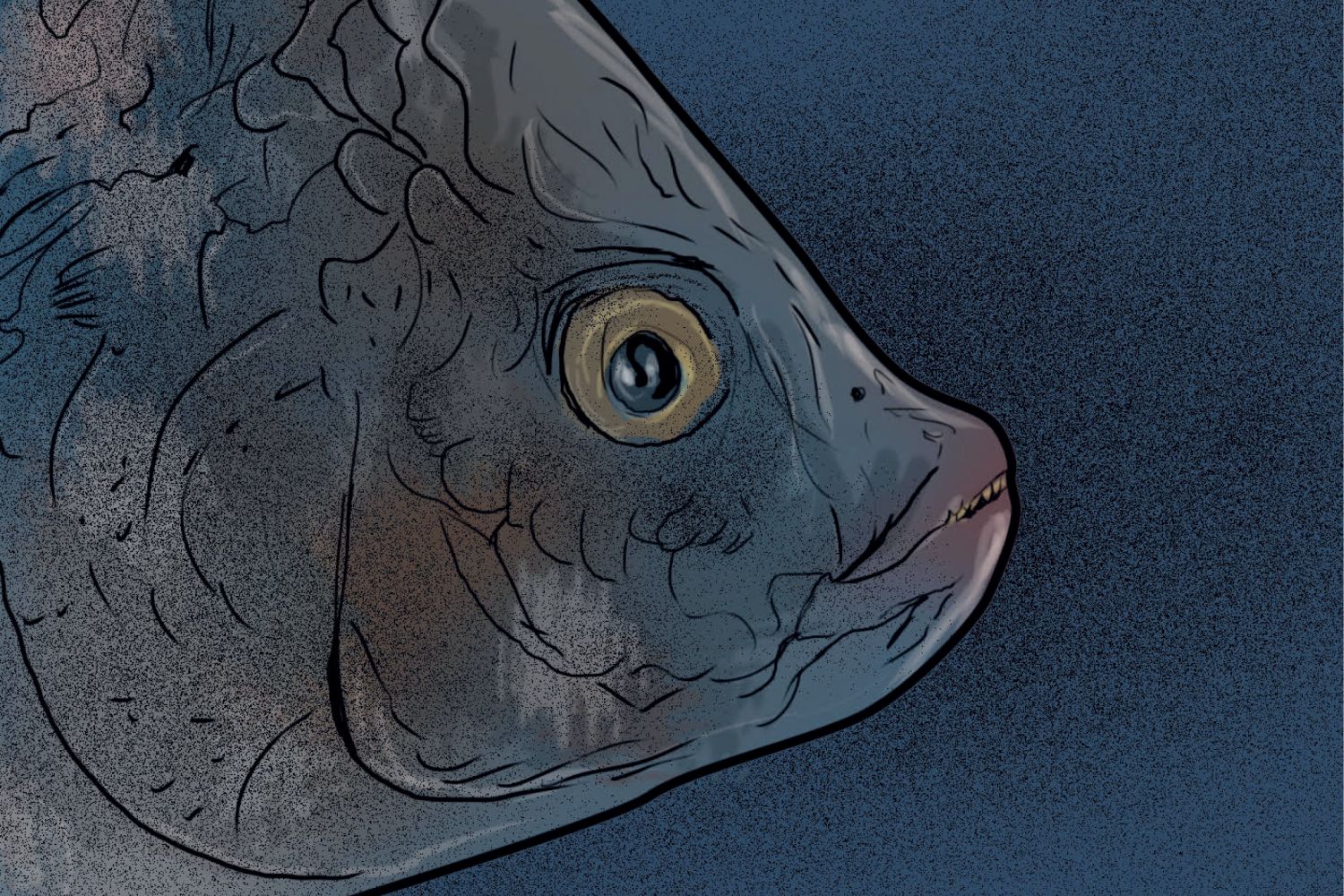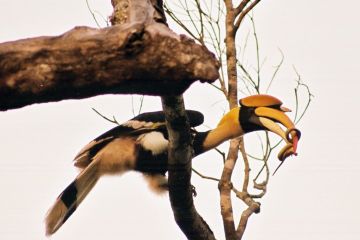
In the centre of the shop, as the crowd streams by, an albino fish in a glass tank has caught everyone’s eye. People cast longing glances as it sways gracefully, its metallic scales glinting in the afternoon sun. The arowana is the most expensive aquarium fish in the world, whose effusive tranquillity can set you back by a few lakh rupees. For many, particularly the Chinese, it is a harbinger of good luck.
A ferocious predator, the arowana has survived since the age of the dinosaurs. Yet today it is a bit of a contradiction—an endangered species that is also mass-produced in fish farms across Asia.
So it is no surprise to find arowanas here, tucked away on West Mada Street in Kolathur, north Chennai. As aquarists across India know, this is the country’s largest ornamental fish market. A long line of aquarium shops stretches for almost one kilometre, spilling on to numerous side alleys and then to South Mada Street.
On the side opposite the shop, the crowds are less respectful, even raucous. The street is unexpectedly devoid of vehicles, letting pedestrians ogle the fish on display. Transparent polythene bags filled with fish hang from a stand, neatly in rows and columns; the prices scrawled hastily with a marker. An omnipresent musty odour persists, like a patch of moss shielded from the sun in a rainforest.
The display mostly comprises cichlids, one of the most species-rich families of vertebrates, more than 800 in number. Gold, silver, electric yellow, black and white; several shades of blue; some with an orange-ringed black spot on its tail, others mostly dark but with blue-green spots, the range is impressive. The light entering the packets refracts through the water, creating a phantasmagoria of colours for customers.
Along the street, signboards abound with pictures of fish. Glass tanks are stacked one on top of the other, with rusty oxygen tanks in the corner. Some have plastic bags with fish scattered on the ground. Shopkeepers are packing them in polystyrene boxes, shipping them off to Delhi, Itanagar, Baroda, Hyderabad, Bangkok, Singapore and Kuala Lumpur.
“The hobby is growing like crazy in India,” says Shankar Balasubramanian, an ornamental fish consultant from Chennai.
And then there are shops specialising in the stuff that is indispensable to keeping fish—tanks, air pumps to bubble air through the tank; a host of filters to keep the water clean: super biochemical sponge filters, active carbon filters, and top filters; high-efficiency breeding nitrobacteria for sewage treatment; ceramic rings to facilitate these friendly bacteria; and pebbles.
Hobbyists are the engine that drives the ornamental fish market in India. “The hobby is growing like crazy in India,” says Shankar Balasubramanian, an ornamental fish consultant from Chennai.
Subramanian has been coming to Chennai since the 1980s and has observed the ornamental fish trade closely. “Earlier these fish were imported from Singapore and Thailand. Travelling to these places from Chennai was only a three-hour flight,” he says.
This neighbourhood, in the north-west part of Chennai, has become a hub for the trade. Many breeders start with three to four cement tanks. Some have as many as 50. In the formal sector, there are several small scale industrial breeding farms in Chennai.
An additional boost to the industry came with the IT boom. Spending on aquariums has gone up tremendously. “Once a person gets serious, he doesn’t mind spending money to get something unique,” he adds.
And aquarium markets like Kolathur deftly exploit what the American biologist Edward O. Wilson calls biophilia: “The connections that human beings subconsciously seek with the rest of life.” An effort to reach out to something bigger than our lives.
The phenomenon is not restricted to metros. Vaastu and Feng shui have driven the commercial aspect of fish keeping across the country. These practices bestow a high level of importance to aquariums. In particular, these practices emphasised the soothing ambience that aquariums provide to homes, and have become much sought after.
India has around 600 exotic ornamental varieties . At least 200 are bred in different parts of India, from the tiny guppy to the arowana.
“Aquariums have become an essential part of the decor,” says Subramanian. “And when it is recommended by vaastu, they won’t avoid it.”
The Kolathur market is just 30 years old. Its rise is the story of the growth of the ornamental fish trade. It also sustains livelihoods for families involved in rearing and selling ornamental fishes. Perversely, this biophilia may also be responsible for devastating our freshwater ecosystems.
W
orldwide, the aquarium and ornamental species trade are growing at 14 per cent annually. The Marine Products Export Development Authority (MPEDA) estimates that the ornamental fish industry in India is worth ₹300 crore. Across 5,000 aquarium outlets across the country, the industry is estimated to employ nearly 50,000 people. These numbers are expected to go up four times, up to ₹1,200 crore in the next 10 years, according to MPEDA.

It’s estimated that India has around 600 exotic ornamental varieties that have been imported. At least 200 are known to be bred in different parts of India. These range from the tiny guppy to the arowana. Besides these two, another 31 species have been imported for aquaculture—fish for food—such as tilapia.
With no proper law, many individuals—both untrained local vendors and hobbyists—bring alien species into India. As a result, rivers, ponds, and lakes are being slowly invaded by exotic ornamental and aquaculture fish, endangering the survival of native species.
These invasions put many biodiversity hotspots at risk. In the Chalakudy river, a biodiversity hotspot in the Western Ghats, guppies have managed to establish a breeding population. Scientists have also recorded the presence of another four alien ornamental species. These could pose a threat to the 16 endangered and four critically endangered species that currently inhabit the river.
The business is mostly unregulated—neither government nor industry having a protocol for the introduction of exotic species.
Following the devastating floods in Kerala in 2018, a team of researchers led by Dr. A Biju Kumar from the University of Kerala, documented the presence of several alien species—of which the most eye-catching was the 3-metre long alligator gar, and the nearly 200 kilo arapaima.
“When people caught these fishes, it became a celebration, and they started posting pictures on social media. That was when it came to our attention”, he says. According to him, these specimens most likely escaped from illegal aquaculture units that were overwhelmed by the floods.
“Whenever there is an issue of flood or natural disaster, many of these species will reach our waterbodies. But once they establish a breeding population, they can become highly predatory, and threaten the native species”.
These are not isolated cases. Another study reported the presence of ornamental fish in the Western Ghats, while several studies have reported the invasion of rivers like Ganga and Yamuna by the food fish tilapia.
When invasive species enter a habitat, lot of species endemic to that area are at threat. If you look at large rivers, like Cauvery or Periyar the invasive ones thrive as the waters are polluted, or have issues like siltation or eutrophication.
The ornamental fish business is mostly unregulated—with neither government nor industry bodies having a protocol for the introduction of exotic species. In contrast, in England, the Salmon and Freshwater Fisheries Act of 1975, prohibits the transport of fishes within boundary without proper procedure. Other jurisdictions have outright bans—the European Union has banned trade, possession, and transport of 37 aquatic species, and is likely to extend this even further.
At risk are more than 700 freshwater species in India. One study estimates that at least one-fifth of the world’s freshwater species are either extinct or on the verge of extinction. Under the double whammy of climate change and pollution, native species could be pushed over the edge by the ornamentals.
A study by the School of Industrial Fisheries at the Cochin University of Science & Technology surveyed the Bharathapuzha, the second largest river in Kerala, for non-native fish species. Using sampling conducted at landing centres, it estimated that nearly 14 per cent of the catch comprised non-native species. Tilapia accounted for more than 2.5 per cent of the catch from the Bharathapuzha. The report notes: “Its prolific breeding habit and parental care cause space overlap with local species…The ecological consequences of establishment of tilapia in such water bodies could be serious…”
***
S
ambandampillai Sandilyan, a researcher who worked on aquatic invasive species with the National Biodiversity Authority of India, has been looking at the invasion potential of ornamental fish across India. In 2016, his paper in the journal Current Science recorded reports of 27 ornamental species sighted in the inland wetlands. Of these, at least 15 have established themselves by breeding well, often at the expense of native species.
Alien species prey on native species by eating eggs and larvae, or adult fish. Pathogens and parasites also piggyback on these species to enter local water bodies.
“When invasive species enter a typical habitat, lot of indigenous species endemic to that area are at threat,” says Kumar. In fact, invasive species thrive in such habitats. “If you look at large rivers, like Cauvery or Periyar in Kerala, or the reservoirs along the Western Ghats, the invasive ones thrive as the waters are polluted, or have issues like siltation, or eutrophication”, says Kumar. “The invaders can take advantage of such deteriorating ecosystems better.”
As Sandilyan notes in his paper, these alien species change the aquatic environment. They alter nitrogen and phosphorus levels in the water, change vegetation, and exhaust food resources. The goldfish, for instance, is a bottom-feeder and unsettles the nutrients settled on the bottom. Blue-green algae thrive under these conditions, causing havoc among native species.
Alien species also prey on native species by eating the eggs and larvae, or the adult fish themselves. The goldfish is known to do this. They can also hybridise with native species, narrowing the gene pool further.
Several pathogens and parasites also piggyback on these species to enter local water bodies. An outbreak of white spot syndrome virus in the 1990s is attributed to the import of fish stocks, leading to the collapse of aquaculture in several parts of the country.
The trade has also been identified as a potential pathway for exotic pathogens and parasites. A recent study in the aquarium markets of Arunachal Pradesh and Uttar Pradesh revealed the existence of alien parasitic worms, which were quarantined.
***
T
here are primarily two channels of invasion—via hobbyists and through breeders. The mechanisms are different and driven by various factors. Hobbyists, often unbeknownst to them, acquire ornamental fish that eventually outgrow their tanks. They dispose of them in water bodies, in effect engineering an invasion.
The story of the pleco exemplifies this. Also known as suckermouth catfish, it is an Amazonian species that is tiny, like a butterfly, when it is young. The fish is thrust on unsuspecting hobbyists by shopkeepers.
After tilapia, pleco is the most dominant invasive species. In a place like Kolathur, it’s not surprising to find plecos in a ditch or a drain.
“It’s marketed as a tank cleaner as it scrapes algae sticking to the glass with its sucker-like mouth,” says Subramanian. “It appears to be cleaning the glass.”
The inexperienced hobbyist buys the fish hoping maintenance will be reduced. But the pleco grows rapidly in size—in a matter of months, it could end up occupying nearly half the typical 2-feet fish tank.
“Hobbyists might ask the aquarium shop to take the fish back, but most refuse,” says Subramanian.
The hobbyist, stuck with the fish, doesn’t have the heart to kill it. In many cases, they let them out into a nearby pond, lake, or river. “He will feel like he’s done a fantastic job, and contributed to nature.” Now plecos are a hardy species. In the wild, they can grow as much as one and a half feet. They can also survive outside the water as long as their gills are wet. Subramanian recounts an episode when he saw a few fishermen throw out plecos onto the land—they’re not eaten in India. “I saw 7 or 8 plecos lying on the ground, far from the water body. But you could see them try to get back to the lake,” he says.
“And four made it back!”
Plecos have invaded water bodies across the country. “After tilapia, pleco is the most dominant invasive species,” he says. In a place like Kolathur, he says that it’s not surprising to find plecos in a ditch or a drain.
Subramanian has seen them across the country. “If you go to a place like Jaipur lake, it has a lot of pleco. If you go to deep forests like Tadoba tiger reserve, the lakes there too have pleco,” says Subramanian. From Bengaluru’s Ulsoor lake to Mumbai’s Powai lake, plecos are everywhere.
The other, more common, vector of invasion is breeders. Poor fish breeders, using cement cisterns or earthen ponds, are unable to afford proper fencing or filtering. Consequently, during the monsoon, these sites overflow into adjacent water bodies, and the fish escape.
“If a fish escapes, it is just a matter of a few fishes to the breeder. It doesn’t make sense for him to secure his site,” says Balasubramanian.
Once they enter larger water bodies, they can jump to interconnected lakes. The most extreme case of invasion occurs when these fish cross into new geographical boundaries in river linking projects. Such projects are believed to have caused the introduction of four ornamental fish species in Chennai’s lakes.
***
G.
Thyagarajan’s house is the last one on the unnamed lane parallel to Lake Street. Outwardly, the neighbourhood of Vinayagapuram is residential. But the profusion of concrete fish tanks, concrete rings, and mud ponds, along with Retteri lake, gives away one of the largest ornamental fish farm hubs in India.
The 41-year-old Thyagarajan’s family is part of this mushrooming fish trade. Twenty cement tanks, lined in a row, sit in the courtyard of their house, with coconut thatch shielding them from the sun. At the end of the line is Thyagarajan’s house, with corrugated iron sheets for walls, and a coconut thatch roof.

His family—wife and three kids—spend most of the day at a small patio in the front, as a table fan whizzes away. In another row, a few concrete rings are stacked one on top of the other containing fish. Behind the house, where the cows graze, is the shore of Retteri lake.
Thyagarajan is a second-generation fish breeder from Dindigul in southern Tamil Nadu. His father moved to Chennai in the late ’90s after farming became impossible in his village. “He came here as a construction labourer, doing mainly cement centring,” says Thyagarajan. That is when he became friends with a few fish breeders in the neighbourhood and then decided to enter the business.
When Thyagarajan turned 25, he joined his father from Dindigul. The business was booming. Around eight years ago, a little after he married, he decided to set up on his own. For this, he needed `1.4 lakh. There were some savings, but most of the money came from pledging his wife’s gold.
“The initial investment is in renting land, some coconut leaves for fencing, and breeding tanks,” he says. Thyagarajan didn’t start with cement tanks—he opted for the low-cost version. Cement rings of around 1 foot diameter, stacked one on top of the other. With his investment, he built approximately 50 rings—10 for parent fish, and 40 for breeding.
Thyagarajan specialises in the cheaper varieties, the bread and butter of the trade—angelfish, oscar fish, guppies, goldfish, and chocolate molly. These species are readily available and aren’t difficult to breed. After growing them for around 3 to 4 months, breeders can sell them for as low as 50 paise to ₹4 per fish. Rarer varieties fetch more. Tiny shrimps and tiny lobsters, for instance, bring between ₹50 and ₹100. For Thyagarajam, selling a thousand fish would fetch around ₹500. At this rate, he makes ₹20,000 to ₹40,000 a month.
S.
Jesuraj says fish breeding began in Kolathur in the early 1980s. At the time, it was mostly uninhabited and thickly covered by trees. Kolathur’s appeal is primarily Retteri lake. Jesuraj, a 56-year-old central government employee residing in Kolathur and, more importantly, a hobbyist breeder, says “The pH level of the water is between 6.5 and 6.8. Any fish will breed here,” he says. “Moreover, temperatures in Chennai are conducive to breeding.”
“There was this person from Madurai who built a house here and started breeding fish. He brought two other people from Madurai to help him with the farm,” he says. Within a year, those two set out on their own and brought in more people. Others began to do the same. Jesuraj cites one breeder he knew quite well. “He was from a low-income family. We used to be very close. He attended my wedding, and I attended his.”
When he left his home in Madurai, he only had a chain with him. “He sold a gold chain, and from the proceeds, leased a house and put in some tanks.”
Fish breeding needs to be done scientifically, but people were quick to learn. For instance, Jesuraj says, parent tanks need to be segregated by gender. “Only then will the males be aggressive during breeding,” he says.
Today, 600 to 700 breeders from southern Tamil Nadu practise fish farming in Kolathur. The money is good. Jesuraj estimates that a breeder can earn at least ₹30,000 a month.
Typically, every eight days, the parents are put together in a tank for breeding. Before that, the breeder has to prepare the water. “If you put the fish in freshly pumped borewell water, they will die,” says Jesuraj. “You have to let the water settle for one day. Salts will settle down, gases will be released, and oxygen levels will increase.”
And then the parent fish have to be removed after 24 hours from the same tank. Else they might end up eating the eggs.
Breeding techniques also need to be adapted to the species. For instance, with egg scatterers, the female scatters the eggs and the male fertilises them while chasing the female. The eggs stick to water plants in the tank or rest on the bed of the tank.

Once they hatch, the larvae grow up to a centimetre after feeding. “A baby fish is like a dart with a tail. So it needs to feed on something smaller than itself,” says Jesuraj. Chennai has abundant natural sources of Daphnia—a minute crustacean used as food for larvae (newly hatched fish). Breeders go to nearby lakes around dawn to harvest Daphnia, which rises to the surface only at that time of the day.
The larvae are usually transferred to a pond as it provides a more conducive environment for them to grow. “Within two months, it will grow by another 2 inches,” says Jesuraj. And then the fish will be ready to be sold in the market.
Earlier, breeders would grow larvae in the cement tank itself, but this is not efficient. For one, the breeder will have to invest in feed, and a pond provides a better environment for fish.
Today, 600 to 700 breeders from southern Tamil Nadu practise fish farming in Kolathur. The money is good. Jesuraj estimates that a breeder can earn at least ₹30,000 a month. They have done well enough that they are now leasing ponds elsewhere to grow fish. Many have also bought land in and around Kolathur.
The MPEDA, a government agency, also provides subsidies for those interested in constructing fish farms. Grants can go up to ₹4 lakh for fixed infrastructure: Bricks, sand, motor, glass tank for the oxygen cylinder, packing equipment, oxygen cylinder with a regulator, air pumps etc.
At the upper end are companies that are professionally doing this. “Although the basic principles are the same, their technique is different. For instance, they use better water filtration techniques, and the breeding takes place in a closed environment,” says Subramanian.
Jesuraj’s friend, who sold his chain to get into the business, is doing quite well. “Today, he lives in a palatial house down the road,” he says.
“Even to meet him, I need to make an appointment!”
T
he reasons that stimulated the ornamental fish trade have also led to the crisis in freshwater bodies. Over the years, with breeders growing the same fishes, prices have plummeted. “Every Tom, Dick, and Harry is growing the same thing. This drives people to exotic species in order to stand out,” says Subramanian.
He has seen how these fish can escape from their cement tanks, swimming miles away. In 2014, as part of the Chennai Fishkeepers, a local club of hobbyists in Chennai, he and J. D. Marcus Knight undertook a survey of water bodies in Chennai.
First, they organised a field trip to Chembarambakkam lake, one of Chennai’s main water sources. They identified several species, many of which were invasive—pleco, flower horn, jewel cichlids, tilapia and gambusia.
One particular fish stumped them, they couldn’t identify it immediately. “Since it was a baby fish, it meant that it was born there,” says Subramanian. He suspected that it was from the Trichopsis genus, but couldn’t identify the species without an adult. A more thorough search followed when they discovered a few adults.
They identified the species as the croaking gourami. Native to Southeast Asia, it is found across the world in aquariums. Now, Chembarambakkam lake is about 25 km from Kolathur where gouramis are bred. How did they reach here? It is one of three major lakes in Chennai along with Red Hills and Poondi. The three are connected by canals to ensure water is shared equally.
“Whenever there is flooding in Kolathur, water flows into Red Hills lake. So any fish that goes to Red Hills obviously can reach Poondi or Chembarakkam via the canal,” says Subramanian.
Chennai’s flat terrain also makes it more suitable for species to move from one water body to another. “When there’s flooding, the water can move in any direction,” says Subramanian. Any fish found in one of the three big lakes—Chembarakkam, Red Hills, and Poondi—would be prominently present in the other two as well.
Another species Subramanian encountered is pacu, a South American fish that looks similar to a piranha, though it isn’t as dangerous. He came across pacu in a small rain-fed pool near Poondi lake. Now pacu, unlike gourami, is not bred in Kolathur.
Instead, Subramanian suspects that it came from the other side of Poondi which is in Andhra Pradesh. “Over there, pacu is bred as a food fish,” he says.
“So it’s possible that the pacu in the rain-fed pool escaped from the aquaculture unit in Poondi,” he says.
***
R
esearchers across India have established how several species, bred for both ornamental and aquaculture purposes, have turned invasive. Cyprinus carpio, a common carp, is an instance of a fish introduced for aquaculture. Introduced between 1939 and 1957, it contributes more than 7 per cent of inland production. Sightings have been recorded in the Ganga, Loktak lake in Manipur, and several of Kerala’s reservoirs such as Periyar dam. These expansions have come at the expense of native species. For instance, the mahseer, considered sacred and fed by devotees in Kerala, has been nearly driven to extinction by the introduced carp.
Gambusia is a species with a unique trajectory. It was most likely introduced during British rule for mosquito control. An insectivore, the fish consumes the mosquito larvae that sit on the surface of the water.
The African catfish was introduced into India from Bangladesh in the states of West Bengal, Assam, and Andhra Pradesh. In 1993, it was introduced in Kerala for farmers to rear in ponds. Kumar says that the advantage with the African catfish is that they eat practically anything. “Many of the areas in south India, where they are grown, breeders will use waste from farmhouses, such as chicken waste, as feed,” he says.
But soon, the catfish escaped into adjacent water habitats during the monsoon. Some reports detail how it did this by slowly crawling on the land with the aid of its strong pectoral fins.
As the population of the African catfish exploded, the indigenous catfish began to dwindle. “In water bodies like Mattupetty (Idukki) and Periyar, the African catfish has become the dominant species where you would earlier find indigenous catfish”, says Kumar.
Today, reservoirs, ponds, and tanks in Kerala have reported this species, driving out native catfish. In Vembanad lake, the infestation is so severe that African catfish poses a threat to native cichlids. The fish has also been reported in some of India’s biggest rivers: Ganga, Yamuna, Sutlej, and Godavari.
The national committee for the introduction of species for India banned the rearing of the African catfish in 1997. Yet, no real measures have been taken to remove them from these aquatic habitats.
Interestingly, as the African catfish has prospered, farmers have seen a corresponding decline in demand. “Now that these have become quite common, and they are less tasty than the indigenous variety, there isn’t much demand,” says Kumar.
Tilapia, native to Africa, has been introduced for its excellent yield. Across the country, small farmers breed tilapia in ponds for consumption. They have a high survival rate as the fish is a mouth-brooder.
The pleco is an ornamental species that has invaded the drains of Thiruvananthapuram in Kerala. A study by Biju Kumar revealed that pleco invasions correspond to a decrease in native species. It consumes the eggs of native species and leads to local extinction of indigenous varieties. Plecos have also caused massive damage to lakes in Madurai.
Gambusia is an invasive species with a unique trajectory. It was most likely introduced during British colonial rule for mosquito control. An insectivore and a top dweller, the fish consumes the mosquito larvae that sit on the surface of the water.
As it was deployed further, it turned invasive, infecting native species with pathogens that it carries. According to Subramanian, there are other alternatives. “We have native species like the killifish that can be used for mosquito control,” he says.
Tilapia is another species that has turned highly invasive. Native to Africa, it has been introduced across the world for its excellent yield. “It was seen as a protein source for the poor. And it’s so easy to breed, any household can maintain it,” says Balasubramanian.
Across the country, small farmers can be found breeding tilapia in small ponds, which they harvest for consumption. In captivity, tilapia can breed once in 3 weeks, producing nearly 100 offspring.
They have a high survival rate as the fish is a mouth-brooder. Once eggs are laid, the female collects the eggs and keeps it in her mouth to protect them. “Other fish cannot eat the eggs. Once the babies hatch, they swim around in the mother’s mouth,” says Balasubramanian.
Once the mother is confident, she will let the offspring out. “Even at that stage, when the mother feels there is some danger around, she will open her mouth, and the babies are back in safety,” he adds.
As a fish explorer, when I see tilapia in a water body, I can confidently say there are no small fish in that water body.
These qualities have also caused it to overcrowd water bodies once they escape, and out-compete native species. Offspring become sexually mature as early as 3-4 months. So a single pair can overwhelm water bodies in as little as a year.
“If you ask me, any given day, the biggest threat is tilapia, not only in India but all over the world,” says Subramanian. According to him, there are only a few rivers in India where you don’t find tilapia.
The fish is an omnivore—primarily surviving on algae, but also eating other fish. It can thrive in a wide range of water salinity, oxygen levels, pollution levels and habitats; from closed ponds to fast-flowing rivers. It is practically impossible to remove once it’s invaded a water body.
“As a fish explorer, when I see tilapia in a water body, I can confidently say there are no small fish in that water body. Either they have gone to some other place, or this fish has eradicated them successfully,” says Balasubramanian.
“And the population won’t stay there. They will have competition among themselves, and begin to spread out rapidly elsewhere,” says Balasubramanian. “Just like lantana, you can’t eradicate it,” he adds.
***
O
n paper, the Ministry of Agriculture has enacted guidelines for importing ornamental fish. But enforcement is lax, and traders and hobbyists do not adhere to these guidelines at all. India also has a National Committee on Introduction of Aquatic Species, which is authorised to screen entry of exotic species. But again, enforcement is non-existent.
Kumar says that India needs a central agency for management and eradication of invasive species. “The first step for this agency would be to document ecosystems that are highly impacted by invasive species“, he says.
“We need to have large-scale approach simultaneously, persistently, and religiously”. But this is a time-intensive process. Subramanian, who surveys rivers professionally, explains. First, multiple locations have to be studied—upper tributary, middle, and lower tributary. Then each section has to be repeated in different seasons: summer, post-monsoon, winter, and pre-summer.
Even then, there’s no assurance that all species will be captured. “Anything underwater, they’re difficult to survey,” he says. Subramanian says that out of 10 fish, you may be lucky to trap three. “The moment you put your leg in the water, they get the signal to hide. If you’re experienced, you will get three; otherwise, you don’t even get one.”
Several species hide under crevices and come out only to eat at night. “So you have to do a night survey,” says Subramanian. And then some species restrict themselves to deeper waters. Subramanian estimates that it takes nearly 200 trips to survey one river accurately.
The next step is eradication, and restoration of our freshwater ecosystems.
“Right now, the only way to control them is culling. And if you go for culling, the issue is that you will have to kill all the fishes”, says Kumar. “Even then, total elimination will be difficult, because unless you totally drain out the reservoir, you cannot cull all the fishes”, he says.
***
A
round the world, steps to tackle invasive species have been attempted. In May this year, Cyprus began culling lionfish, a species that is popular with aquarium owners. Native to the South Pacific and Indian Oceans, it began to appear in US waters after pet owners started releasing the fish from home aquariums into the sea. They have begun to appear all across the Atlantic in Europe, and colonised the entire coast of Cyprus within a year.
In 2013, the Kerala government attempted to remove the African catfish manually from Periyar as it was threatening six globally threatened, endemic species, including the only species of snow trout found south of the Himalayas. The government planned to net the catfish and manually remove them. The effort was not very successful.
Kumar adds that the government needs to come out with a policy for dealing with invasive species before they overwhelm ecosystems. “Early detection is one of the best methods of control and management. Once they establish and totally devastate the ecosystem, then its rather difficult”, he says.
The trade is completely unregulated. “We need to have some kind of quarantine system, before introducing these species in an extensive manner throughout India”, he adds.
The other important step is to educate hobbyists and more importantly, shopkeepers.
A study by Madurai Kamaraj University, scouring online shops for aquariums, found that 19 states and Union territories trade in exotic ornamental fish. Andhra Pradesh, Chandigarh, Gujarat, Karnataka, Kerala, Maharashtra, New Delhi, Tamil Nadu and West Bengal are some of the leading states in the trade.
“Unfortunately, shopkeepers can’t identify species by their proper name,” says Subramanian He cites the example of a cichlid called severum. “In India, this fish is referred to as Shivram,” he says. “If you go to the shop and ask for severum, he will give you a blank stare. But if you ask him for Shivram, he will say yes.”
This lack of knowledge can percolate down to hobbyists. “Hobbyists won’t know anything about the life cycle and requirements to take care of the fish if they don’t even have the right name,” he adds.
A
fter eight years, Thyagarajan is considering introducing ornamental fish farming in his village in Dindigul. “I already have a small patch of land,” he says. But the hitch right now is water—the same issue that drove his father to Kolathur more than 20 years back. “A borewell needs to be dug, and we might have to go as deep as 500 feet,” he says. “Let’s see. If I can arrange the money, I will try,” he says.
For Thyagarajan, the dangers of invasion seem distant from his concerns. “It lets me make a decent living without back-breaking work,” he says. “This job has let me send my two children to a good school.
“They will, hopefully, lead better lives than I have.”





